Country Canada Time zone AST (UTC-04) Area 72,520 km² | Created 23 June 2005 Postal code prefix A0P Population 2,160 (2006) | |
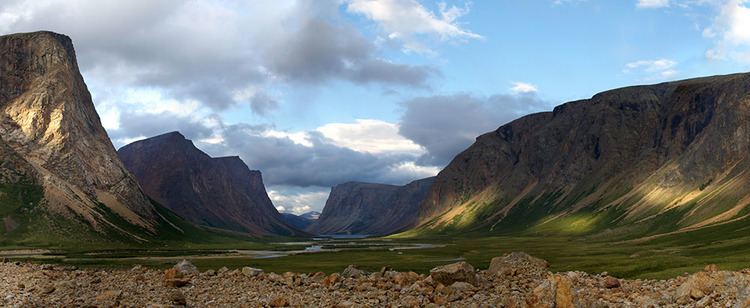 | ||
Federal riding Labrador (electoral district) | ||
Nunatsiavut celebrates 10 years
Nunatsiavut /nuːˈnɑːtsiəvᵿt/ is an autonomous area claimed by the Inuit in Newfoundland and Labrador, Canada. The settlement area includes territory in Labrador extending to the Quebec border. In 2002, the Labrador Inuit Association submitted a proposal for limited autonomy to the government of Newfoundland and Labrador. The constitution was ratified on 1 December 2005, at which time the Labrador Inuit Association ceased to exist, and the new Government of Nunatsiavut was established, initially being responsible for health, education and cultural affairs. It is also responsible for setting and conducting elections, the first of which was executed in October 2006. An election for the Ordinary Members of the Nunatsiavut Assembly was held on 4 May 2010. The Nunatsiavut Assembly was dissolved on 6 April in preparation for the election. Its incumbent president is Johannes Lampe who assumed office in 2016.
Contents
- Nunatsiavut celebrates 10 years
- The people behind the inukshuk nunatsiavut drummers
- Self governance
- Nunatsiavut Assembly and Executive Council
- Departments
- Government buildings
- Geography
- Land disputes
- Religion
- Ethnic origin
- Employment
- Transportation
- Notable people
- References
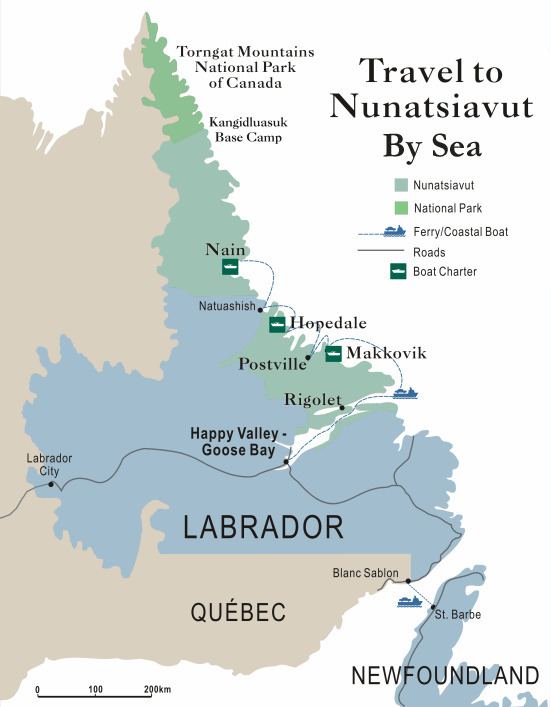
In Inuttut, Nunatsiavut means "Our Beautiful Land". This name was ratified by the Labrador Inuit Constitution and passed by the Labrador Inuit Association in 2002. A primary objective of autonomy is for the preservation of the Inuit culture and language, as well as the environment through environmental stewardship.

Nunatsiavut is counted in the census as Division 11.
The people behind the inukshuk nunatsiavut drummers
Self-governance
The Labrador Inuit Association had filed a land claim for portions of Labradorian land in 1977. In 1988, the Labrador Inuit Association, the government of Newfoundland and Labrador, and the government of Canada began negotiations based on the land claim. An agreement-in-principle was achieved in 2001, and on 26 May 2004, the agreement was ratified by over 75% of eligible voters subject to the land claim.

On 22 January 2005, the Inuit of Nunatsiavut signed the Labrador Inuit Lands Claims Agreement with the federal and provincial governments covering 72,520 square kilometres (28,000 sq mi) of land, including the entire northern salient of Labrador north of Nain as well as a portion of the Atlantic coast south of there. The agreement also includes 44,030 square kilometres of sea rights. Although the Inuit will not own the whole area, they were granted special rights related to traditional land use, and they will own 15,800 square kilometres (6,100 sq mi) designated Labrador Inuit Lands. The agreement also establishes the Torngat Mountains National Park Reserve in the northern area of the land claim.

The Labrador Inuit Lands Claims Agreement is a treaty between the Inuit of Labrador, the provincial government of Newfoundland and Labrador, and the federal government of Canada, that is constitutionally protected under the aboriginal and treaty rights of Aboriginal peoples in Canada granted by section 35 of the Constitution Act, 1982.
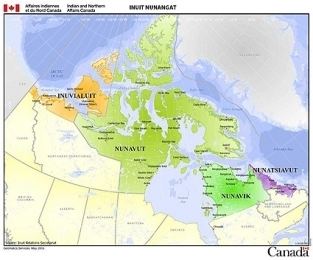
The self-governance agreement included a transfer of $130 million from the federal Government of Canada in compensation for the forced relocation of the Inuit in the 1950s; $120 million to establish self-government; royalty payments from the provincial government for resource extraction; and land, mineral, and marine rights. Unspecified benefits for Inuit in Labrador not within the settlement area were also part of the agreement.
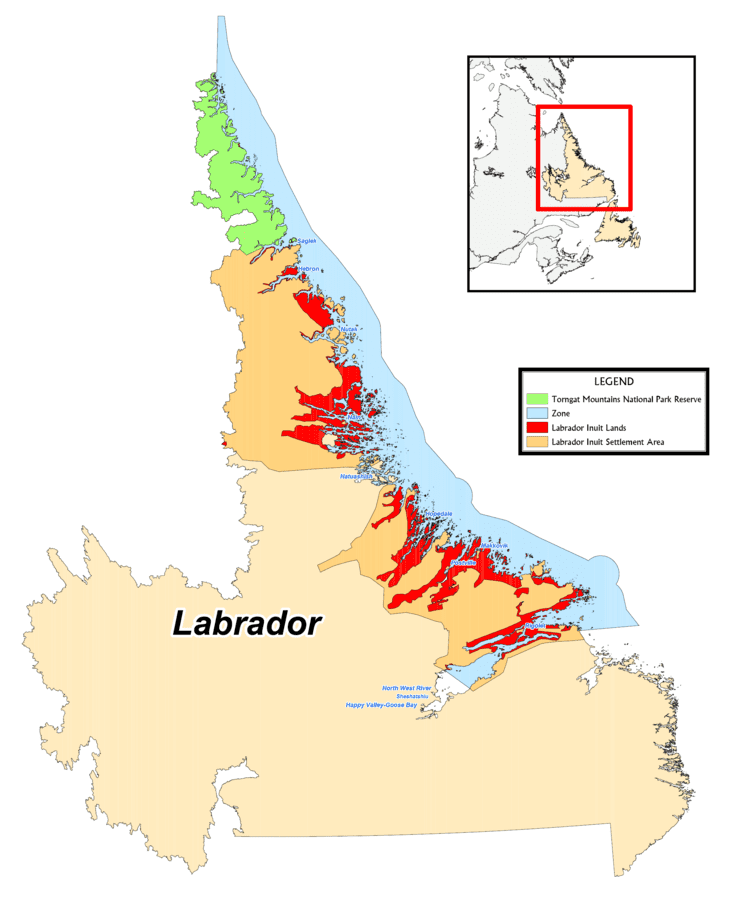
The agreement was ratified by the Labrador Inuit, the Legislative Assembly of Newfoundland and Labrador, and the Parliament of Canada, where it received Royal Assent on 23 June 2005.
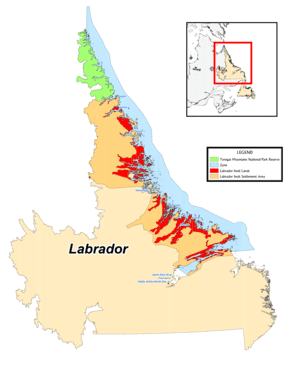
On 1 December 2005, the constitution was formally adopted, and a swearing-in ceremony was held for the first cabinet, an interim government which consisted of members of the Labrador Inuit Association board of directors. This day marked the official transfer of power from the provincial government to the newly formed Government of Nunatsiavut "to make their own laws relating to cultural affairs, education and health".
In October 2006, Nunatsiavut held its first election to form a nine-member government, which was sworn in on 16 October in Hopedale.
Nunatsiavut Assembly and Executive Council
The land claim agreement provided for the establishment of the Government of Nunatsiavut to represent the residents of the land claim area and any Labrador Inuit living elsewhere in Canada. Nunatsiavut remained a part of Newfoundland and Labrador, but the Government of Nunatsiavut acquired the jurisdictional authority over health, education, and justice in the land claim area. Nunatsiavut operates under a consensus government within the parliamentary system of Canada.
The legislature of the government is based in Hopedale, and its administrative centre is in Nain. It is subject to the Nunatsiavut Elections Act. The Nunatsiavut Assembly consists of a minimum 16 members, including:
There are currently two Inuit Community Corporations, NunaKatiget Inuit Community Corporation and Sivunivut Inuit Community Corporation, and 18 members in the Assembly.
From the Assembly, a member will be elected to act as First Minister. The Assembly would act as a forum for discussion of laws, and it will oversee the Executive Council.
The Nunatsiavut Executive Council will be appointed by the First Minister. It will implement laws, develop and implement policy, initiate and prepare legislation, oversee the administration of the government, and be accountable to the Assembly.
Inuit Community Governments were established in Nain, Hopedale, Makkovik, Postville and Rigolet. Each consists of a municipal council, elected from and by both Inuit and non-Inuit residents, and is led by an AngajukKâk, a chief executive officer and mayor, who must be Inuk.
Large settlements of Labrador Inuit outside the settlement area will be represented by Inuit Community Corporations.
The AngajukKâk of each Inuit Community Government and the chairperson of each Inuit Community Corporation will represent his or her community in the Nunatsiavut Assembly.
Departments
There are seven departments headed by 6 ministers with Nunatsiavut Secretariat headed by the President of the Executive Council.
Government buildings
While each community has government facilities, there are two key sites:
Nunatsiavut Government Head Office is located at 25 Ikajuktauvik Road in Nain, NL houses the administrative functions of the Government of Nunatsivut.
The Nunatsiavut Assembly sits at Nunatsiavut Assembly Building in Hopedale, Newfoundland and Labrador. The building opened in 2012 facing Hopedale Harbour and is the first permanent home since 2008 (previous assemblies met at various locations in Hopedale).
Geography
Nunatsiavut's land claim includes the area surrounding Hamilton Inlet and then the coastline north to a point south of Davis Inlet and the Mulligan River also forms part of the boundary. It also claims the land north of the Notakwanon River and as far north as Cape Chidley. Nunatsiavut is the southernmost recognized Inuit territory in Canada.
Nunatsiavut's territory consists of 2 geographic regions. The southern portion contains Rigolet, Makkovik, Postville and Hopedale and has a population of 1,403 (as of 2011). The northern portion contains Nain as well as the Torngat Mountains National Park. Nunatsiavut is located near the Innu communities of Natuashish and Sheshatshiu as well as North West River, Happy Valley-Goose Bay and Cartwright. It is also near the Quebec settlements of Kuujjuaq and Kangiqsualujjuaq.
Land disputes
The Labrador Métis Nation filed a challenge to Nunatsiavut's claim in the Supreme Court of Newfoundland. The federal government has also suggested that the LMN join Nunatsiavut. The LMN's original land claim included all of Labrador south of Nain.
The Makivik Corporation had their claim to the coast between Killiniq Island and Voisey's Bay accepted in 1993 and later asked the federal government not to ratify Nunatsiavut's claims since it overlapped with their claim.
Religion
According to the 2011 census, 98.73% of Nunatsiavut's residents identify as Christian. 11.25% identified as Anglican while 79.62% identified as "Other Christian" (most likely Moravian). 1.49% of Nunatsiavut's residents identified as having no religion.
Ethnic origin
90.23% of Nunatsiavut's residents claim Aboriginal ancestry. 89.08% identify as Inuit. 0.38% identify as First Nation.
Employment
9.81% of Nunatsiavut's population was unemployed in 2010.
Transportation
The MV Northern Ranger (owned by Nunatsiavut Marine Inc.) provides ferry service between Nunatsiavut's 5 communities as well as Natuashish, Happy Valley-Goose Bay, Cartwright and Black Tickle. All 5 settlements also contain airports with flights provided by Air Labrador and Provincial Airlines. No community in Nunatsiavut is road accessible however there have been some proposals to connect Nunatsiavut to the Trans-Labrador Highway.
